- Science Castle Research Fund
- Announcements for middle and high school students
- Information for Teachers
- Digest of Oral Presentations
- Research Tips
Beetle gut bacteria explore the "benefits of living in the gut! [Digest of Science Castle 2023 Kanto Conference
2024.05.31![Bacteria in the Beetle's Intestine Explore the "Benefits of Living in the Gut"! [Digest of Science Castle 2023 Kanto Conference]</trp-post-container](https://s-castle.com/wp-content/uploads/sites/14/2024/05/35c4fade2df48498604439056ed5be59.jpg)
We will provide a digest of the "Science Castle," an academic conference for junior and senior high school students where the next generation of researchers are active, as well as the excitement of the event. In this issue, we report on the presentation by Mr. Yutaka Fujimori, a second-year student at Nirasaki High School in Yamanashi Prefecture, who received the Kanagawa Institute of Technology Award for his oral presentation at the Science Castle 2023 Kanto Conference!
Affiliation and grade are as of the time of the announcement.
Beautiful and Cool! The Wonder of the Yamato Beetle
Hello. My name is Yuu Fujimori from Nirasaki High School in Yamanashi Prefecture. I am researching this common Japanese beetle, Yamato rhinoceros beetle. Yamato beetle larvae grow by feeding on humus and other materials that are mainly composed of cellulose. Beetles, they are beautiful. They are very cool and I love their appearance.
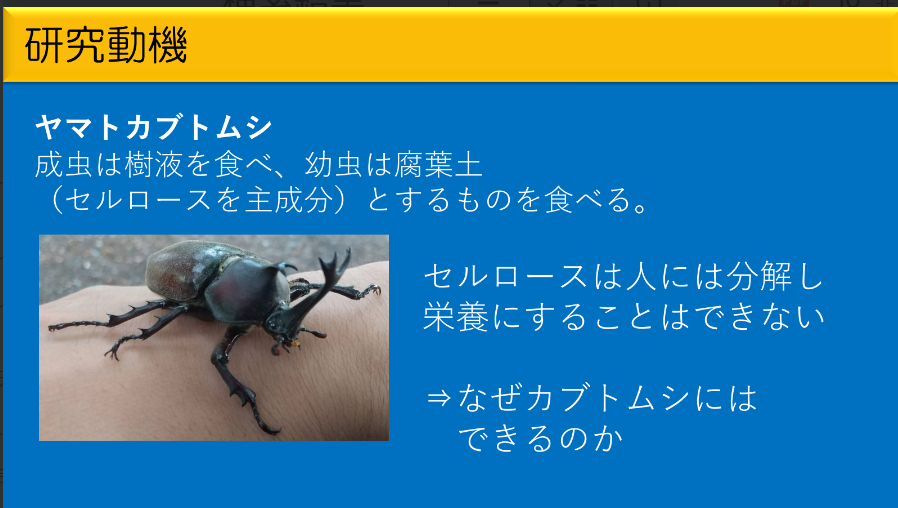
I wanted to know more about them. I began my research with a simple question: "Humans cannot eat cellulose, so why can they eat it, and how can they use it as nutrition? From my research to date, I have learned that the larval gut is an anaerobic and basic environment, and that there is a symbiotic relationship between gut bacteria and beetle larvae. The advantage of this symbiotic relationship for the larvae is that they can obtain nutrition by having the gut bacteria break down cellulose and other substances. The gut bacteria are very important to the larvae. However, I thought that the intestinal bacteria must also have some advantages. So my big hypothesis was that there is a symbiosis between the beetle larvae and the gut bacteria.
Is there a benefit of gut bacteria coexisting with beetles?
First, some of the bacteria in the soil can be activated in the gut, second, the gut is an optimal environment for growth, and third, the gut provides protection from external enemies. Thirdly, the gut provides protection from foreign organisms. Based on this idea, we conducted a verification.
Verification one. One of the major differences between soil and the gut of the beetle is pH. We hypothesized that when the beetles eat the decaying leaves, the soil bacteria enter the gut along with the food, and that the bacteria in the gut, which is normally a basic environment, would have a different activity than in the soil.
We then conducted Experiment 1. Bacteria from the beetle's food, midgut, and feces were cultured on agar medium adjusted to different pH conditions, and the number of colonies on the agar medium was counted.
As a result, the bacteria were divided into 12 types based on color and shape characteristics. The vertical axis of the graph shows the number of bacterial colonies, and the horizontal axis shows the type of bacteria that were divided. Among these, I focused on a type of bacteria from the midgut that could be cultured in large numbers at pH 10. In this study, I named this bacterial strain Zeta. Zeta was found in the midgut at pH 10, but not in the feed or feces. The reason for this is that the collection point was on the surface layer of the soil, which is a relatively aerobic environment. However, the beetle midgut itself is anaerobic, so we thought that the anaerobic conditions and the basic environment of the midgut may be one of the conditions for bacteria from the soil to become active as intestinal bacteria.
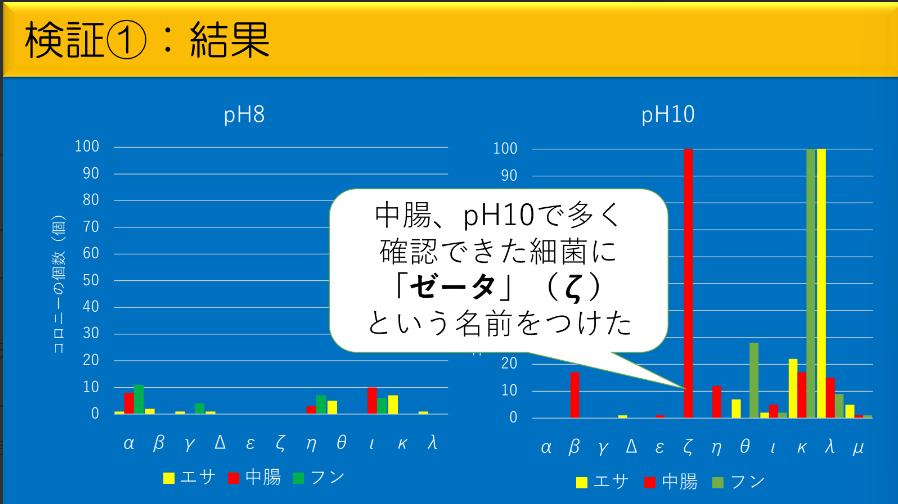
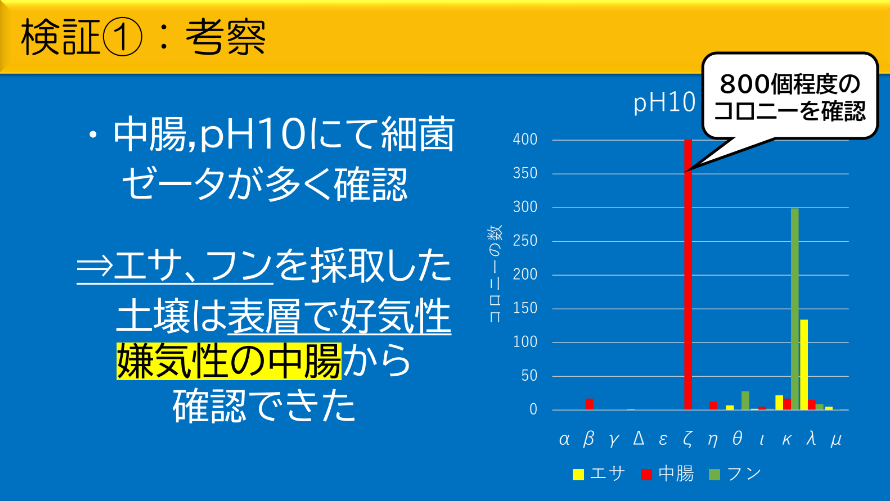
Is the beetle gut an optimal environment for intestinal bacteria?
Second verification. The gut of the beetle is an anaerobic environment, so when nutrients such as cellulose and nitrate ions are available, the intestinal bacteria will grow by consuming cellulose and nitrate ions through anaerobic respiration.
As an experiment, we cultured the strain Zeta, named in Verification 1, for two weeks under different aerobic and anaerobic conditions in addition to pH. The concentration of nitrate ion in this medium was then measured.

Results. Vertical and horizontal lines indicate nitrate ion concentration and pH, respectively, with blue black indicating anaerobic and orange aerobic conditions. As indicated by the white circles, the consumption of nitrate ions is higher in anaerobic and saline environments. A consideration is that the higher consumption of nitrate ions in a saline and anaerobic environment results in a consequential advantage for the beetles to consume nutrients because of the amount of this environment.
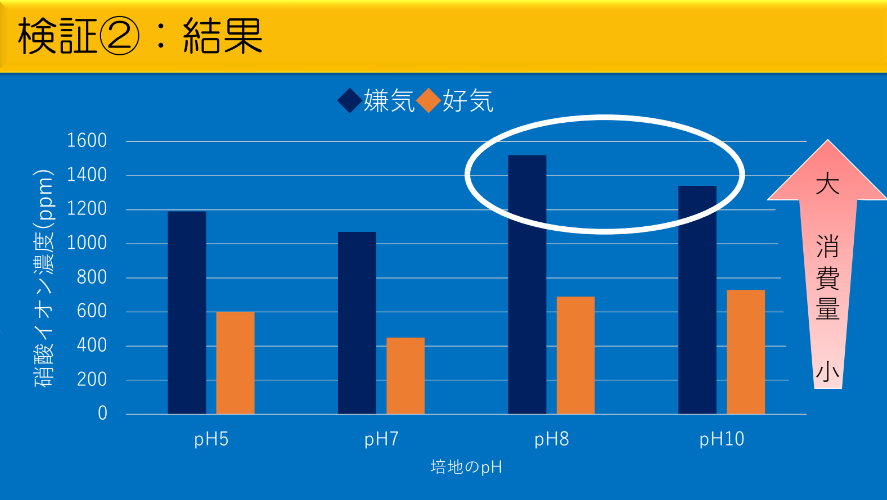
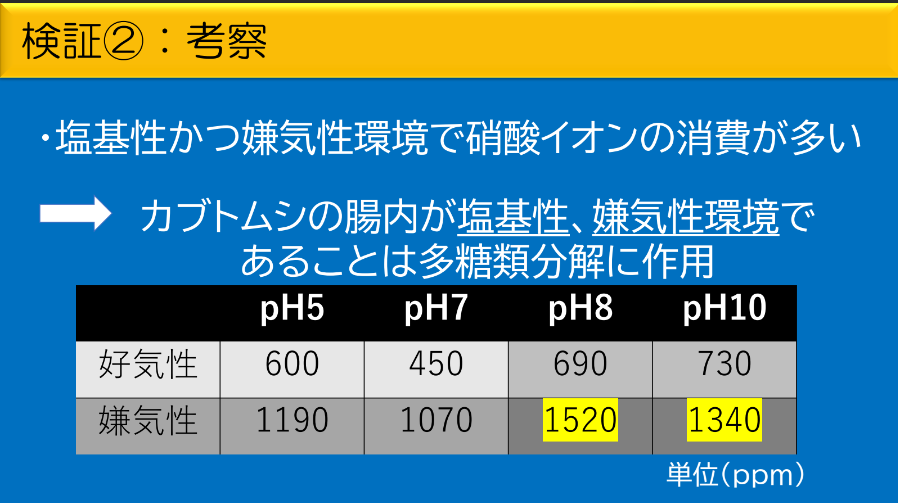
Can being in the gut of a beetle protect you from outside enemies?
As Verification 3, let's start with the external enemy of intestinal bacteria, the paramecium. Paramecium itself is a phagotrophic microorganism that lives in moist, decaying soil. Since the beetle larvae feed on humus, we hypothesized that their habitats overlap and that they may be foreign enemies. As a hypothesis, we hypothesized that if the environment was favorable to the weevil because it disliked bacteria, it would consume less nitrate ions; conversely, if the environment was unfavorable to the weevil because it favored bacteria, it would consume more nitrate ions. Therefore, in Experiment 3, in addition to the flow of Experiment 2, we added a drop of zoospores in the middle of the culture. Results. The format was the same as in the previous experiment 2, but the consumption of nitrate ion was higher in a basic and anaerobic environment.
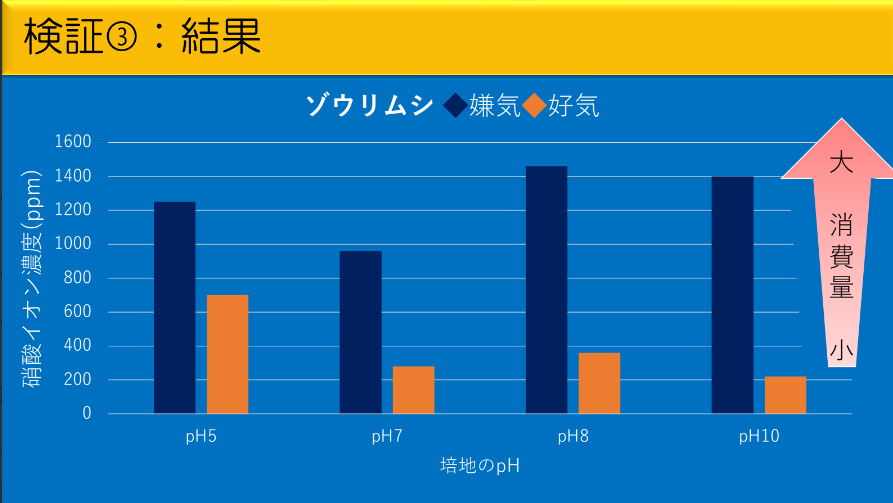

Verification reveals new relationship between beetles and intestinal bacteria
As a consideration, it can be said that the intestinal environment weakens the activity of the paramecium, since there is not much difference in consumption in anaerobic and basic environments in this table in environments with and without paramecium, due to the anaerobic and anaerobic environment. In other words, we can say that the intestinal environment protects the intestinal bacteria.
In summary, the first advantage of the beetles is nutritional security through cellulose degradation, as mentioned above, but the verification of this new symbiotic relationship between the gut bacteria and the beetles has led to the conclusion that the symbiotic relationship is mutually beneficial, as they can "grow in an optimal environment" and "protect themselves from external enemies". In conclusion, there is a symbiotic relationship between beetle larvae and soil bacteria. Thank you very much for your attention.
question and answer session
Kenjiro Hanaoka (Keio University):
I thought the pH point was interesting. pH 10 or 8 is quite alkaline, and I think the pH is so high that it would kill normal human cells. This time, the pH was only 10 or so, which is good. I think it is also anaerobic, but what do you think about that?
Fujimori, Yuku:
In previous studies, the beetle gut has a midgut and hindgut, with the midgut having a pH of 10 and the hindgut having a pH of 8. Based on this, in order to reproduce the gut environment of beetles, we set the conditions according to pH 8 and 10, pH 5 when we measured the pH of the food the beetles actually eat in the soil, and pH 7 for a neutral environment.
Kenjiro Hanaoka (Keio University):
So then you are living in a way that matches the pH in the gut, so that it is advantageous to be at pH 8 there with the bacteria in the gut. I think that is very interesting. I thought that if we looked into the bacteria and what kind of bacteria there are, we would be able to learn more about interesting things. It was interesting.
Fujimori, Yuku:
As for the bacterial zeta we collected this time, I would like to identify the species, but I often fail in the experimental stage, so I am trying to challenge myself.
the heavens (taking) best care(Mitsui Chemicals, Inc.):
Thank you for your very interesting presentation. The first title is why III.(at sentence-end, falling tone) indicates a confident conclusionI am sure you will.
wisteria forest welling (up):
Actually, this research is partly because I have always liked beetles, but there is a study that my seniors were doing that was examining something other than symbiotic relationships. So we were doing research on beetles as a club activity at this school. It was I and II at that time, and now it is III.
the heavens (taking) best care(Mitsui Chemicals, Inc.):.
Have you made a leap forward compared to I and II?
wisteria forest welling (up):
That's right. With I and II, we were studying the characteristics of bacteria and whether or not symbiotic relationships can take over, but this time, the research is more in-depth and in-depth about the benefits of intestinal bacteria, whether or not they can be activated.
the heavens (taking) best care(Mitsui Chemicals, Inc.):
Of course, I and IIcounter for installed or mounted objects (e.g. stone lanterns, gravestones, satellites)I think there was a foundation and there was a III, but we have taken it over.(at sentence-end, falling tone) indicates a confident conclusionYes.
Yasuhiro Iida (Kanagawa Institute of Technology):
I think you were looking at things like consumption, but will you be looking at things like the ability to break down cellulose or something like that?
Fujimori, Yuku:
In examining the activity of bacteria, I thought that if they are consuming a lot of cellulose, then the number of bacteria using it as nutrition is increasing, but it is very difficult to quantify how much cellulose is being consumed in the process. In our search, we found that if there is an increase in the number of bacteria in the intestines, they eventually increase or divide, so they need nutrients. We think that cellulose is consumed together with nitrate ions, and that cellulose is also consumed together with nitrate ions.
Yasuhiro Iida (Kanagawa Institute of Technology):
I think this is one type of fungus, but is there more than one type of fungus doing integrated activity?
Fujimori, Yuku:
There is also a bacterium called Zeta that is in this study, but since it is an intestinal bacterium, we believe that there are a variety of bacteria, just like humans. You used agar medium in the Verification 1 stage. Since only a handful of bacteria can be cultured on agar medium, we would like to control and verify bacteria using various methods in the future.
(*Honorifics omitted)
